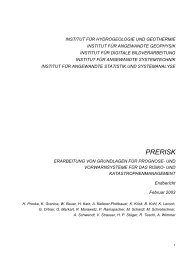Pre-feasibility study for a CDM-AR project in the Cochabamba ...
Pre-feasibility study for a CDM-AR project in the Cochabamba ...
Pre-feasibility study for a CDM-AR project in the Cochabamba ...
You also want an ePaper? Increase the reach of your titles
YUMPU automatically turns print PDFs into web optimized ePapers that Google loves.
o Silvopastoral systems can not compete <strong>for</strong> po<strong>in</strong>t 8,9,10 compared with<br />
traditional land use systems.<br />
o Commercial <strong>for</strong>estry plantations cannot compete with po<strong>in</strong>t 1,2,5,8,9,10<br />
compared with traditional land use systems.<br />
At <strong>the</strong> o<strong>the</strong>r hand, technological and f<strong>in</strong>ancial barriers limit <strong>the</strong> access of farmers to<br />
ei<strong>the</strong>r quality seed or <strong>the</strong> necessary skills <strong>for</strong> successful commercial timber or<br />
agro<strong>for</strong>estry plantations; and <strong>the</strong> barrier due to market risks, of new <strong>in</strong>come streams,<br />
drives farmers to be conservative to ma<strong>in</strong>ta<strong>in</strong> a constant <strong>in</strong>come.<br />
Step 3: Demonstrate that <strong>for</strong>est regeneration will not occur <strong>in</strong> <strong>the</strong> absence of<br />
<strong>project</strong> activities<br />
As described <strong>in</strong> 3.2 over <strong>the</strong> course of <strong>the</strong> past 30 years, <strong>the</strong> <strong>study</strong> area has dramatically<br />
changed. Settlers moved <strong>in</strong>to <strong>the</strong> area to establish small farms, and as a result huge<br />
areas of primary <strong>for</strong>est were cut to make room <strong>for</strong> agricultural production. Total <strong>for</strong>est<br />
area decreased and crop area <strong>in</strong>creased<br />
Livelihood analysis <strong>in</strong> <strong>the</strong> area showed that <strong>the</strong> process of extend<strong>in</strong>g <strong>the</strong> agricultural<br />
frontier will cont<strong>in</strong>ue. Farmers have a <strong>project</strong>ion towards <strong>the</strong> extension of <strong>the</strong><br />
agricultural frontier and not towards re<strong>for</strong>estation, although <strong>the</strong>y recognize <strong>the</strong><br />
environmental problems, de<strong>for</strong>estations causes and <strong>the</strong> benefits which could be obta<strong>in</strong>ed<br />
from <strong>for</strong>estry. O<strong>the</strong>r land uses respond better to <strong>the</strong> direct socio-economic needs of <strong>the</strong><br />
farmers than tree plant<strong>in</strong>g activities (Berger, 2006).<br />
However seed sources do exist nearby <strong>for</strong> natural regeneration, constant agricultural<br />
pressure prevents <strong>for</strong>est from re-establish<strong>in</strong>g. Land pressure and economic necessity<br />
elim<strong>in</strong>ates <strong>the</strong> possibility that after <strong>the</strong> current agricultural cycle, land will be<br />
abandoned ra<strong>the</strong>r than re-enter<strong>in</strong>g a new cycle. Agro<strong>for</strong>estry or <strong>for</strong>estry activities are no<br />
reasonable alternatives without <strong>project</strong> <strong>in</strong>tervention, s<strong>in</strong>ce social and f<strong>in</strong>ancial barriers<br />
are too high.<br />
2.5. Basel<strong>in</strong>e Quantification<br />
Zomer et al (2006), estimated carbon stock, based upon data from sample plots,<br />
literature, and expert knowledge. In comb<strong>in</strong>ation with <strong>the</strong> environmental and edaphic<br />
factors, a spatially disaggregated map is derived of carbon basel<strong>in</strong>e stock across <strong>the</strong><br />
area.<br />
Zomer et al 2006, modeled <strong>the</strong> changes <strong>in</strong> carbon through a land use cycle, such as<br />
annual cropp<strong>in</strong>g, or shift<strong>in</strong>g agriculture and <strong>the</strong> average Carbon stock <strong>for</strong> each land use<br />
type was predicted (table 3.1).<br />
<strong>Pre</strong><strong>feasibility</strong> report Chapare<br />
11




